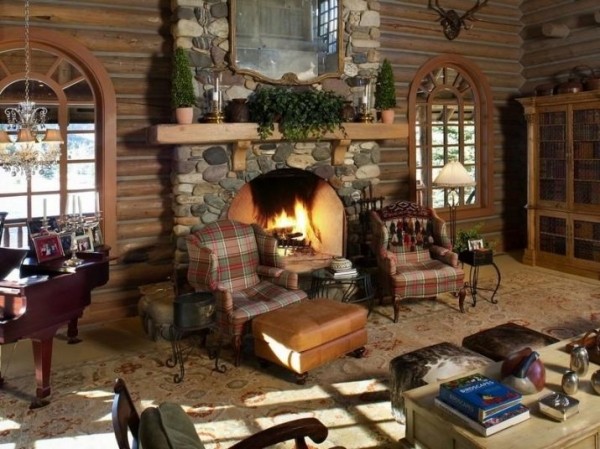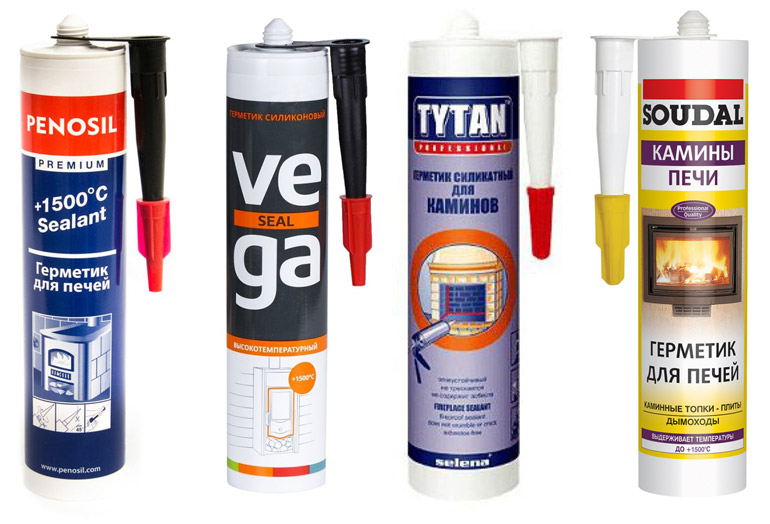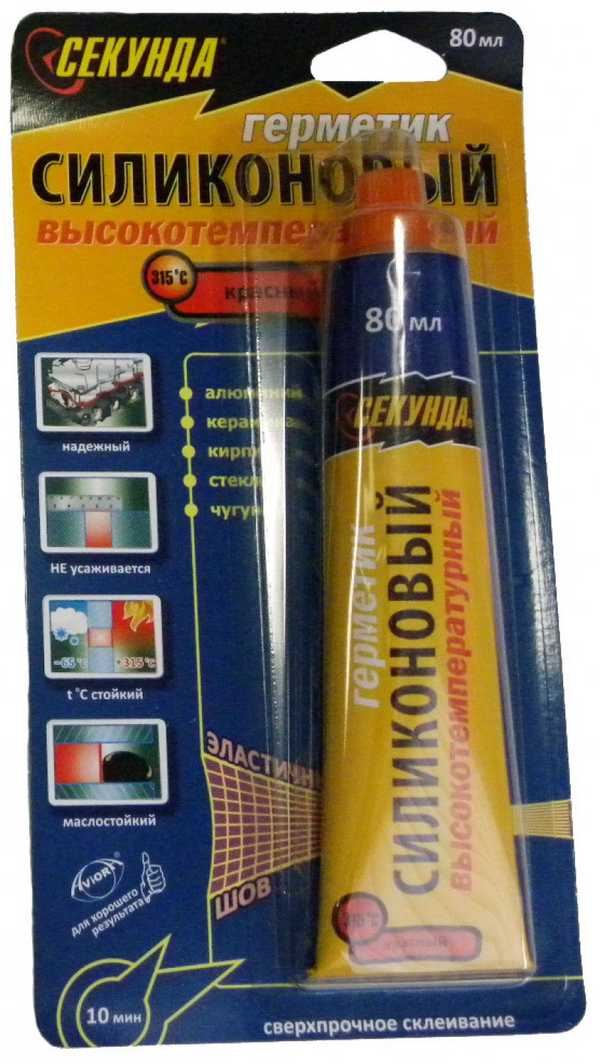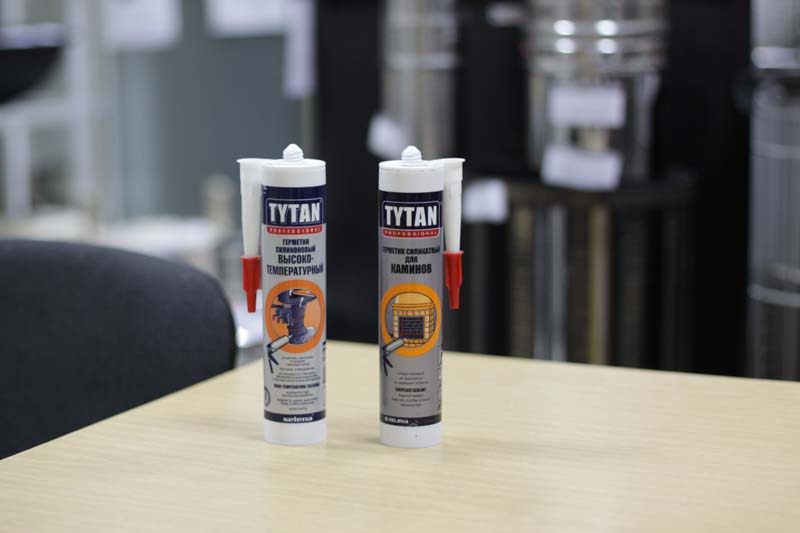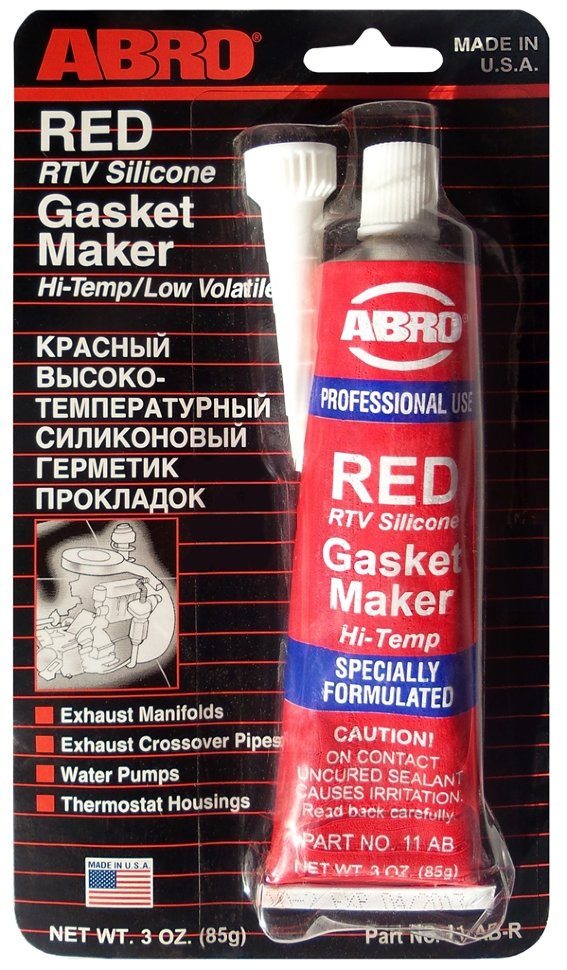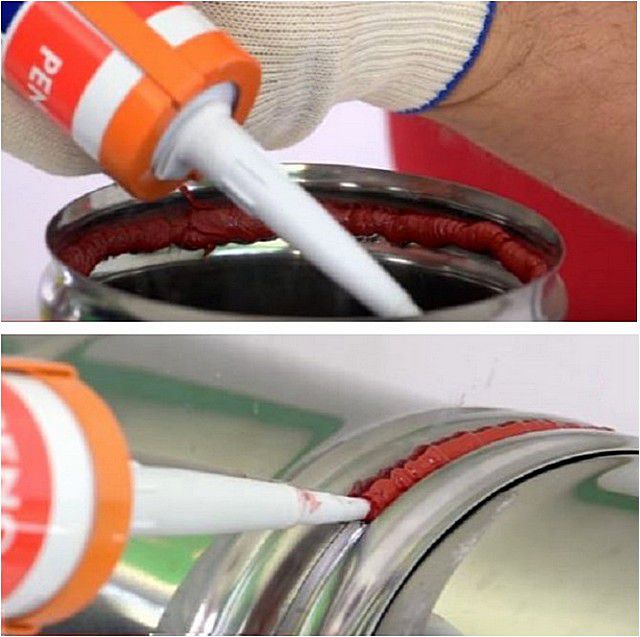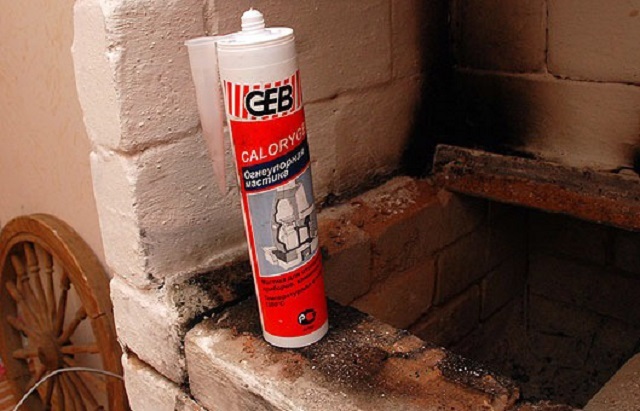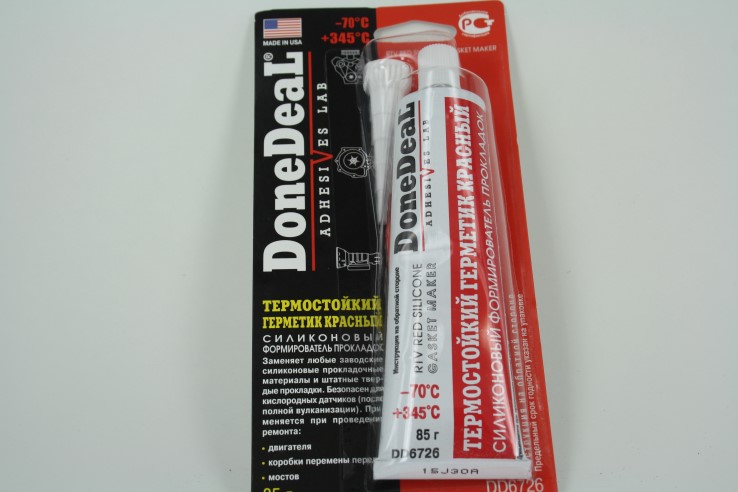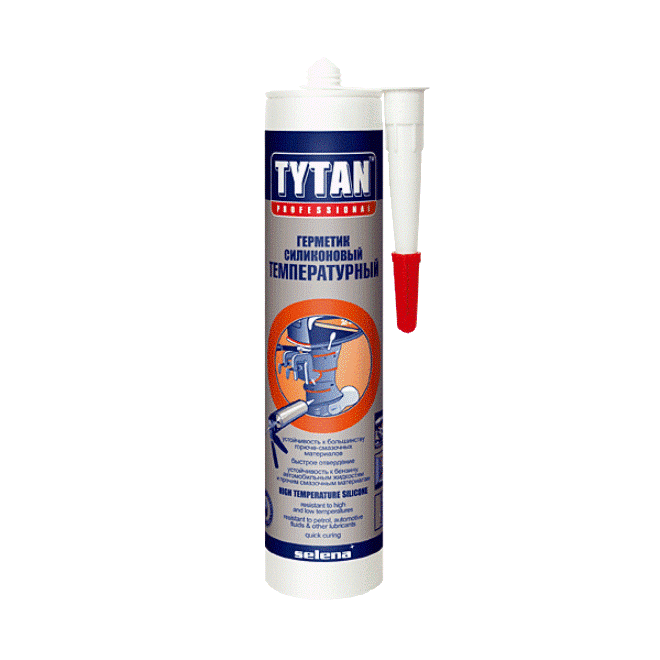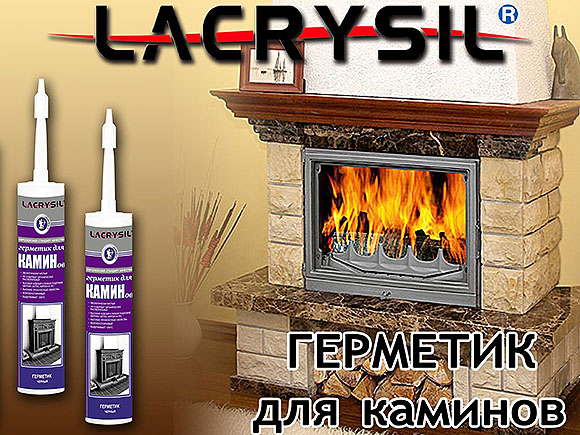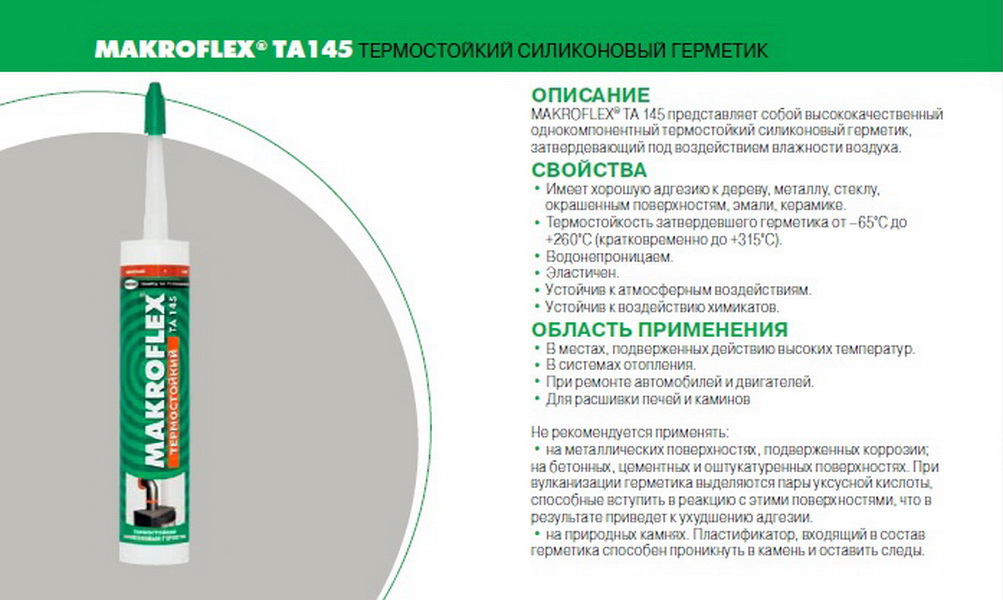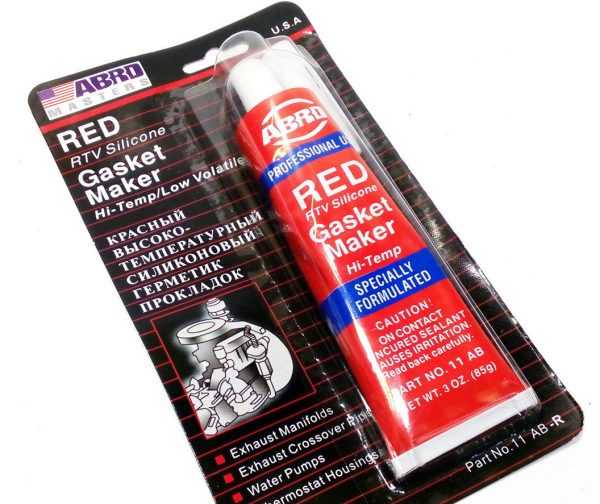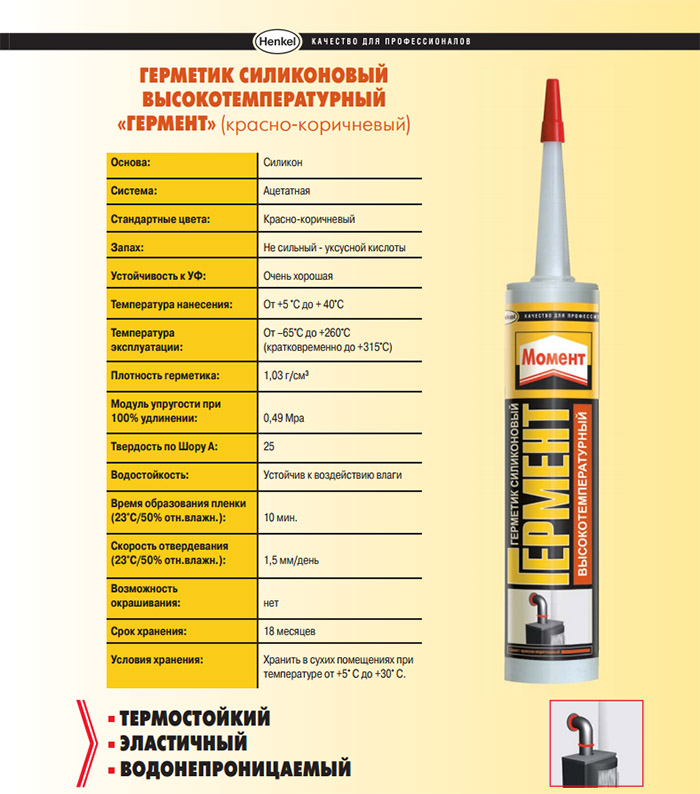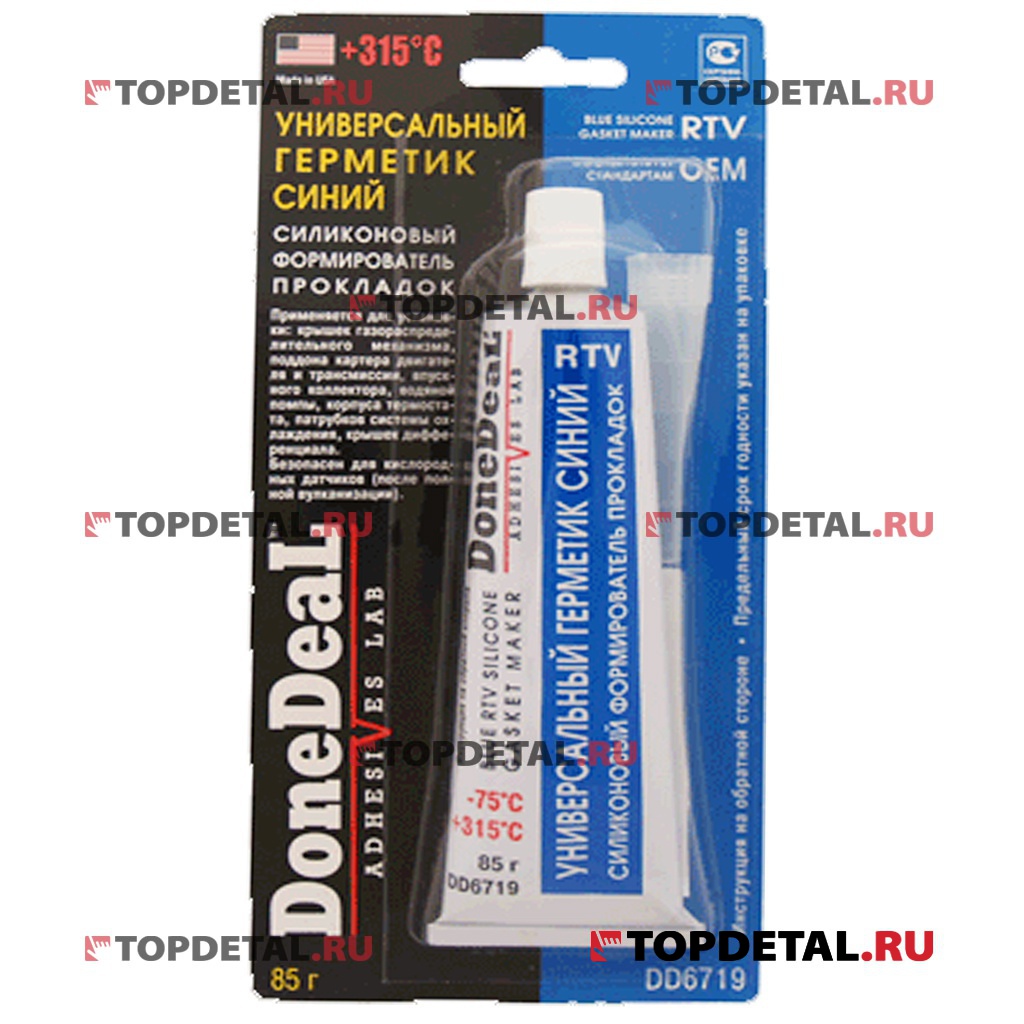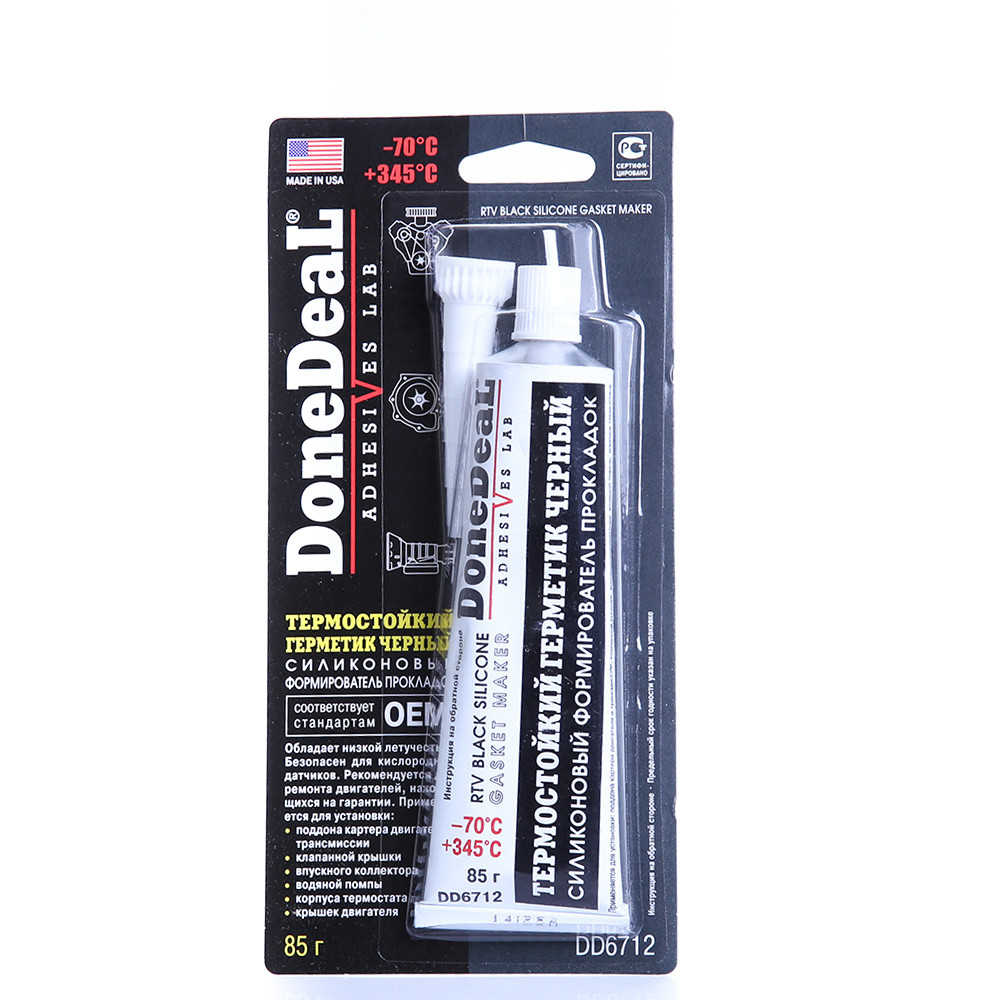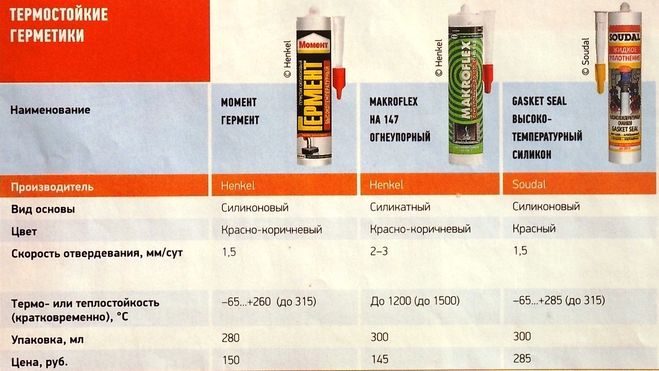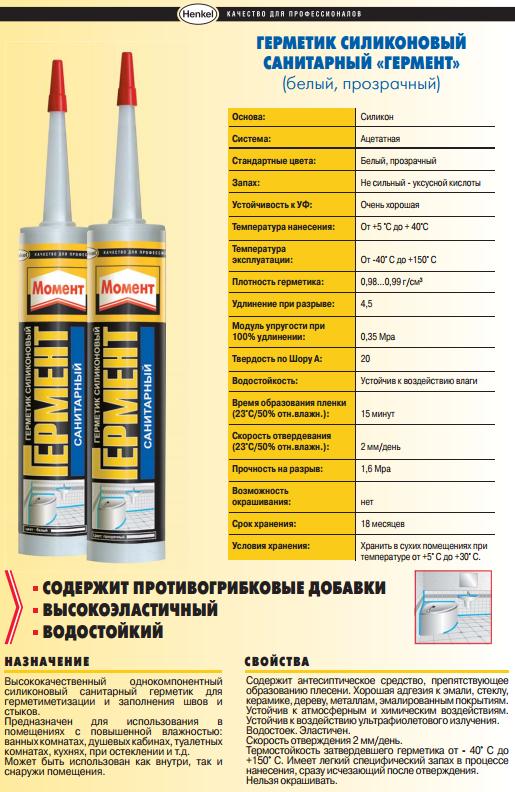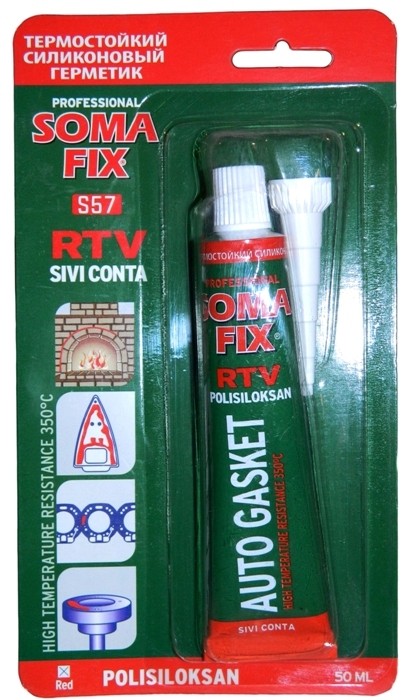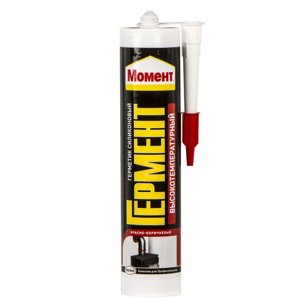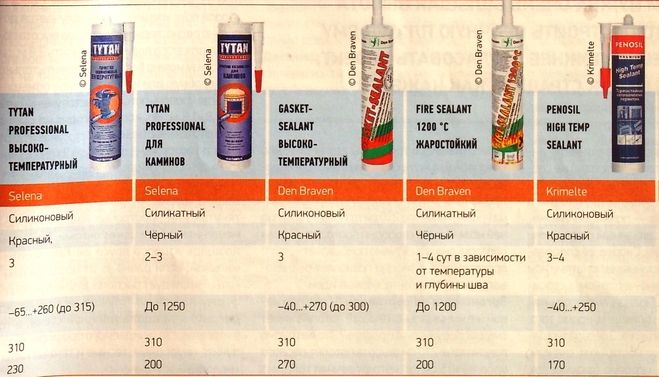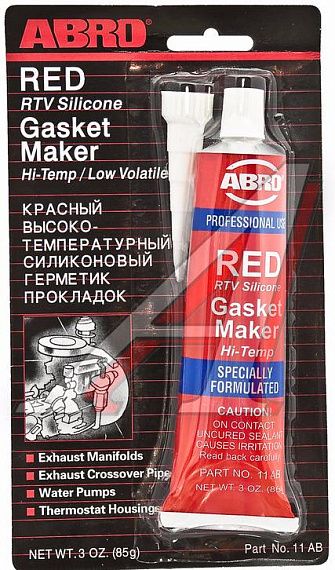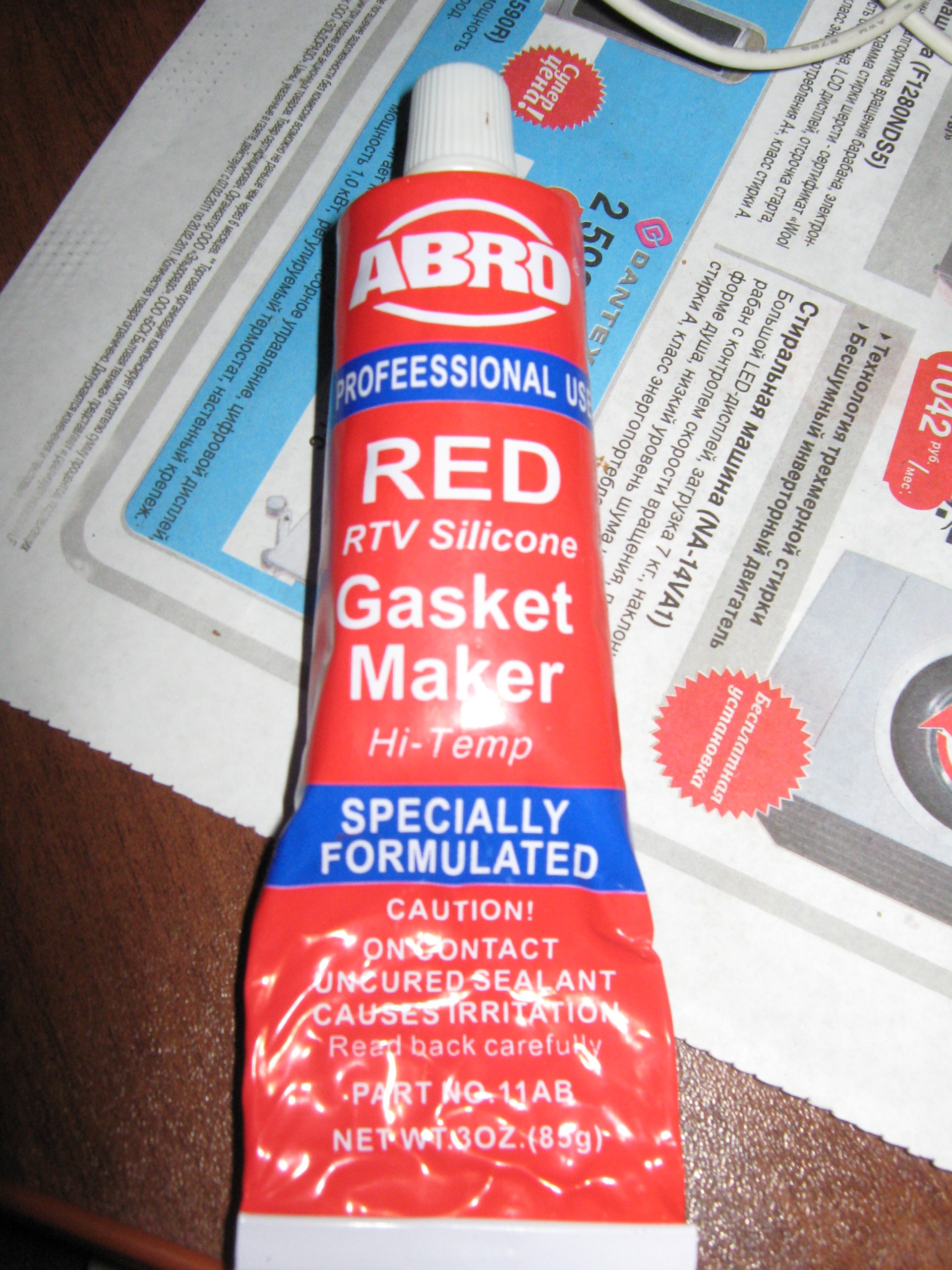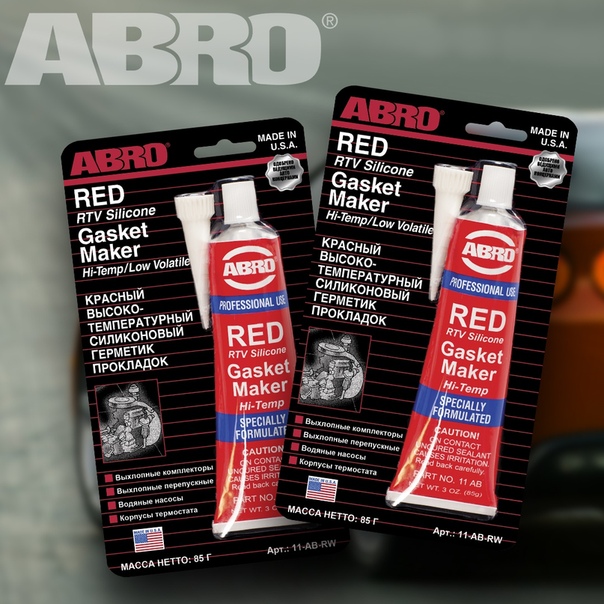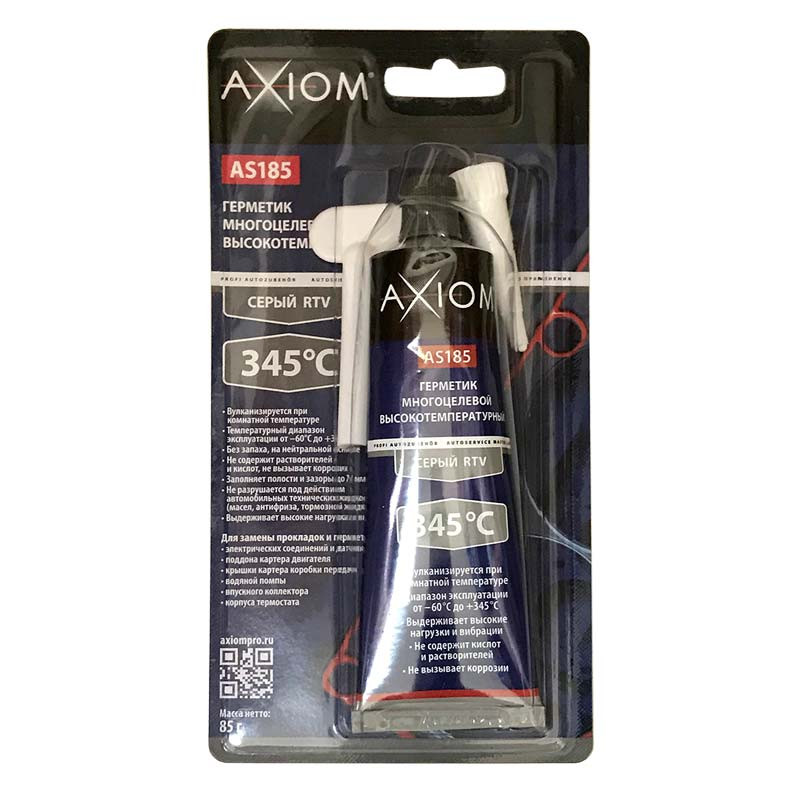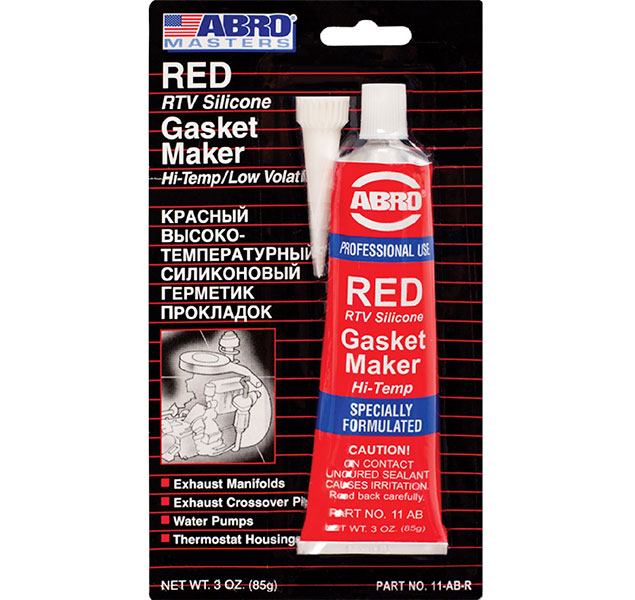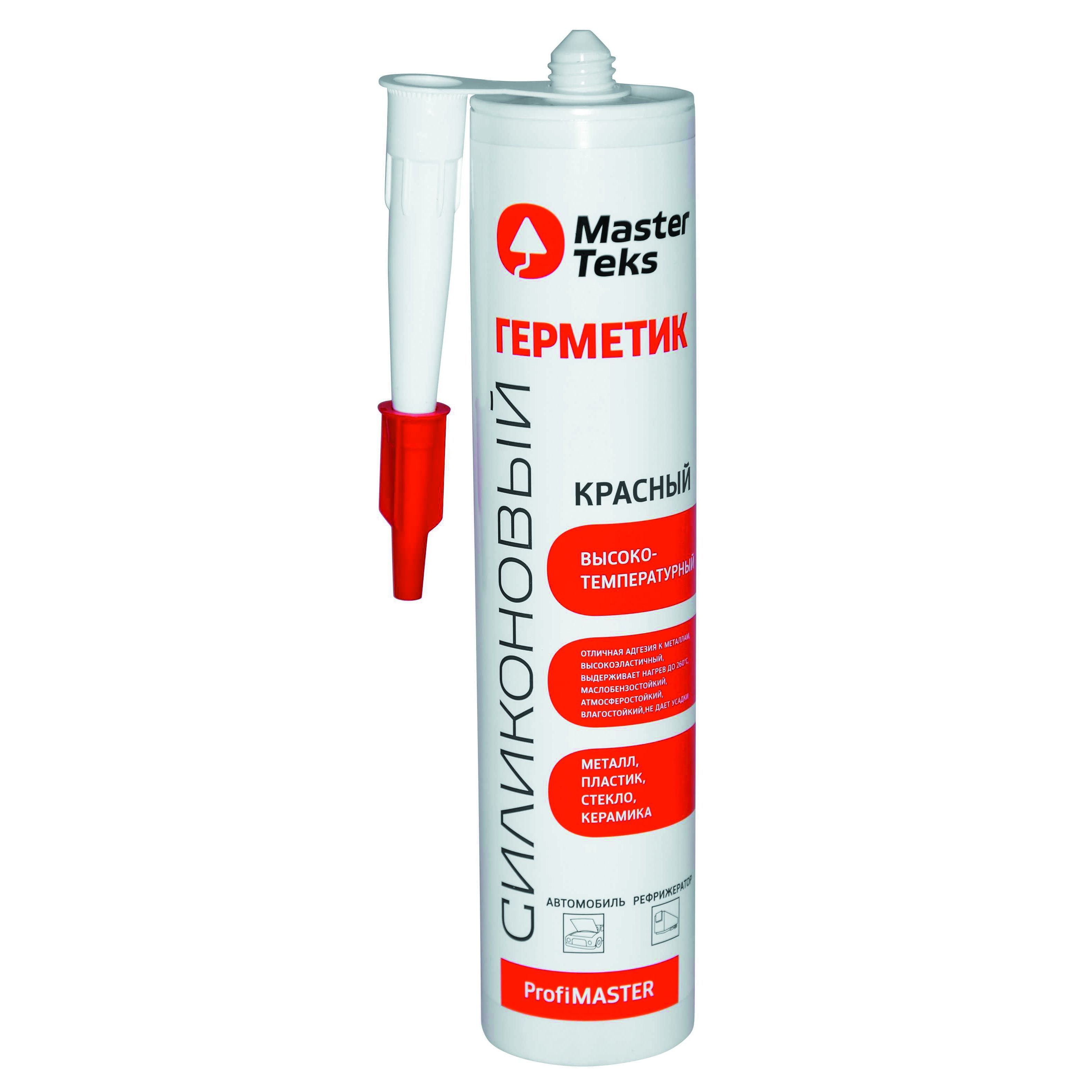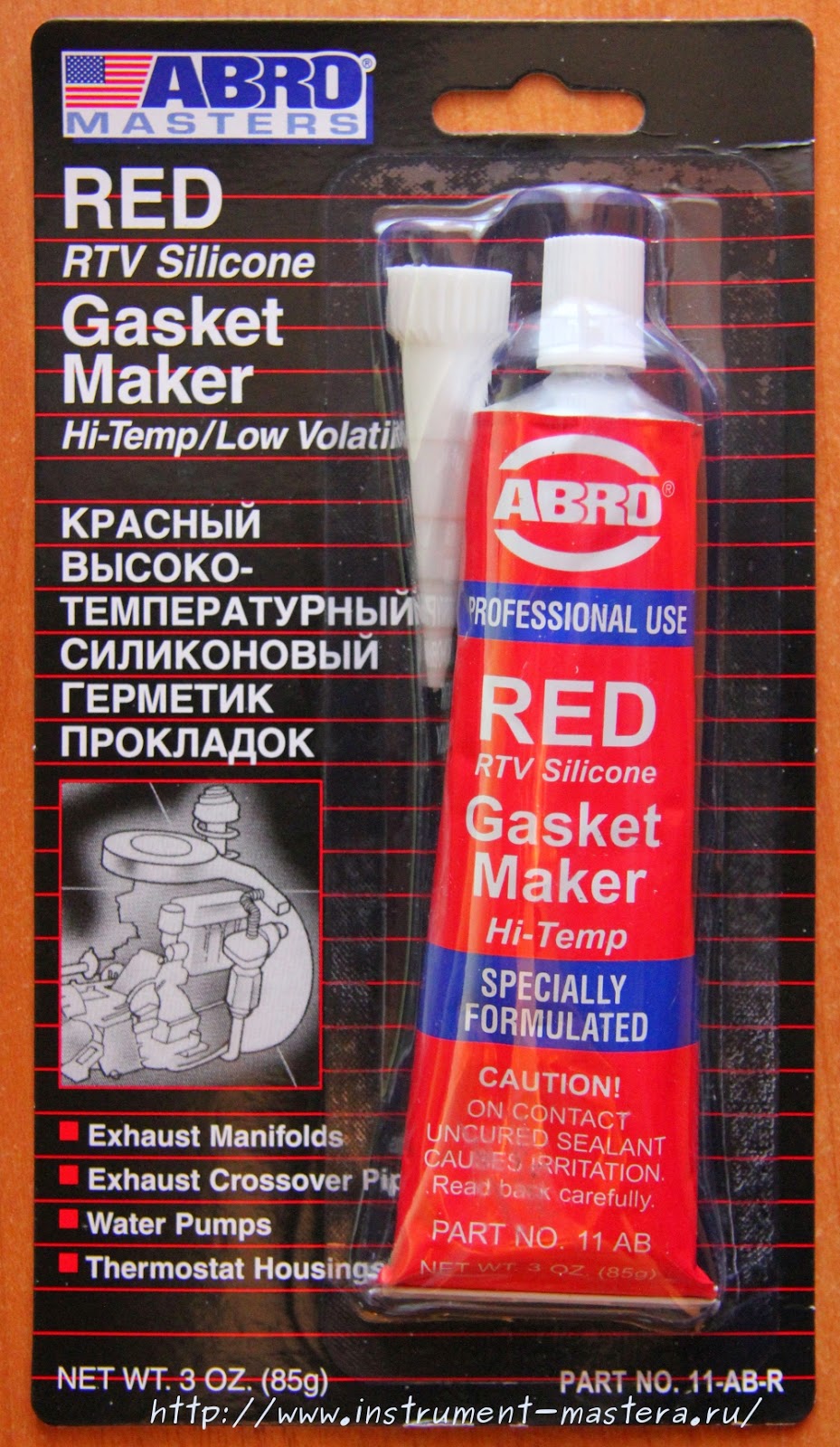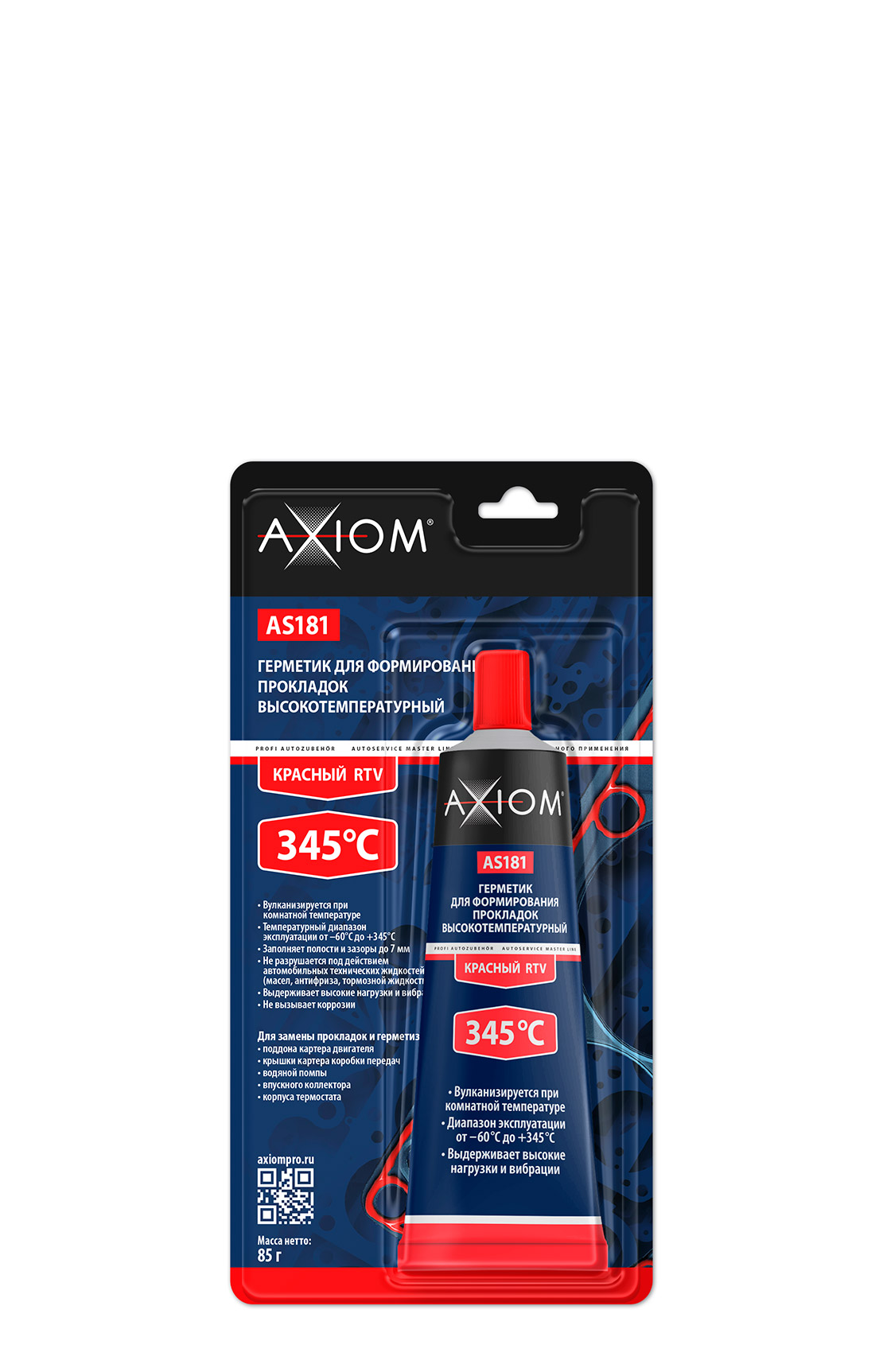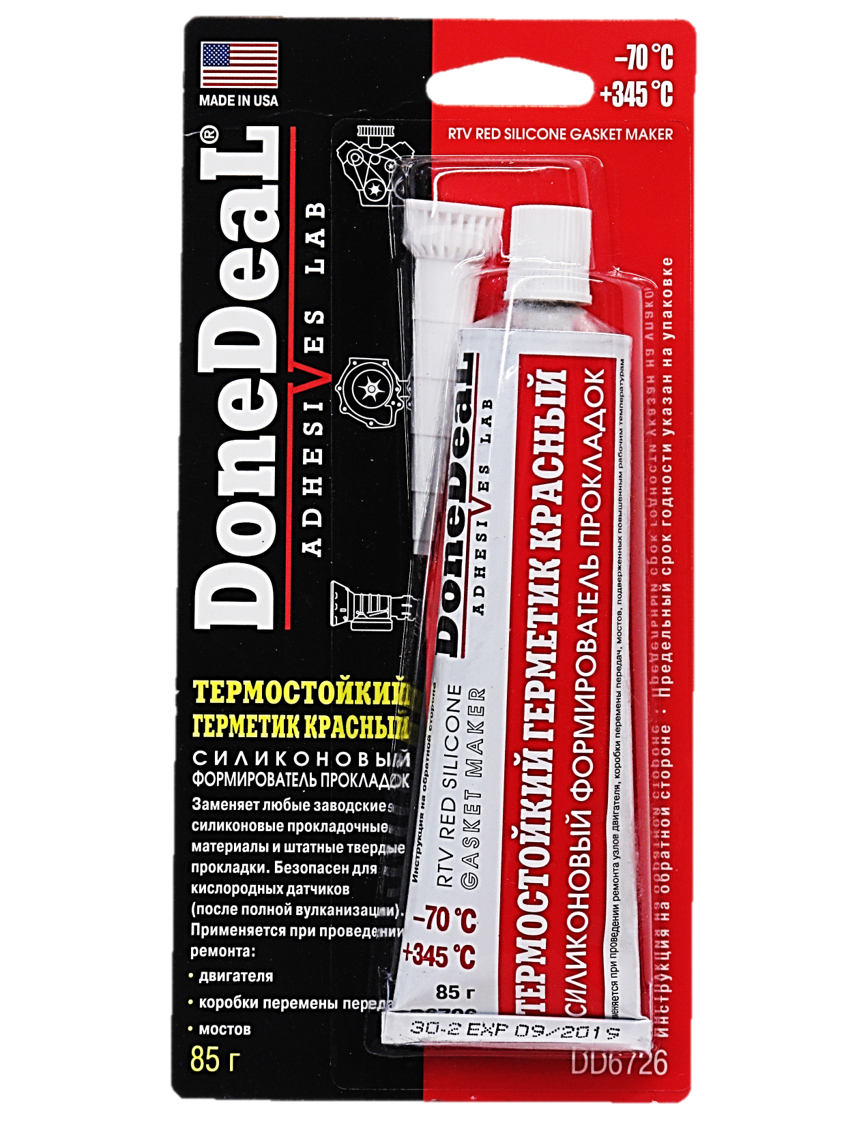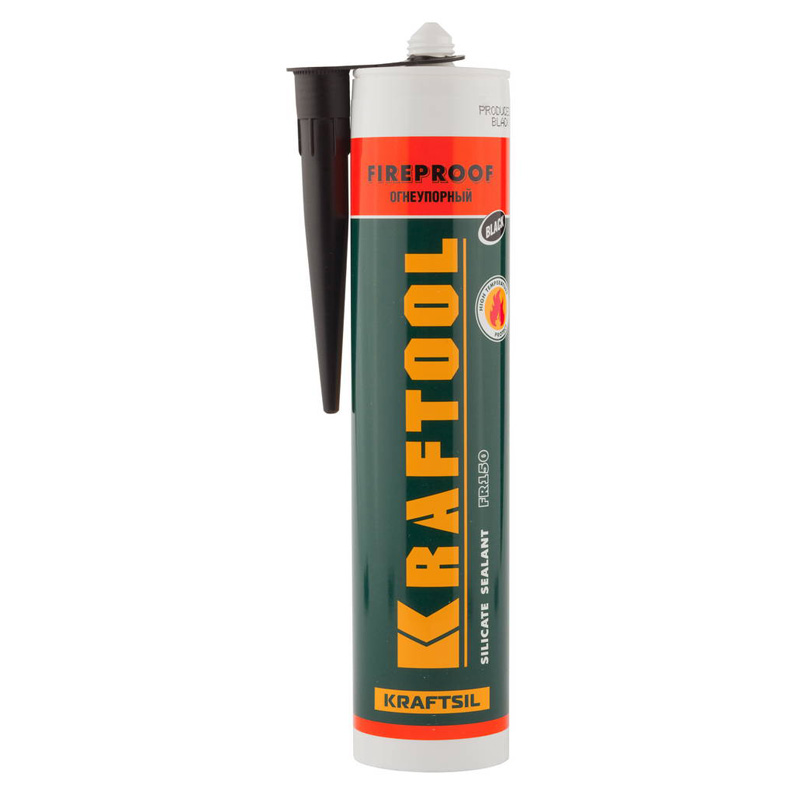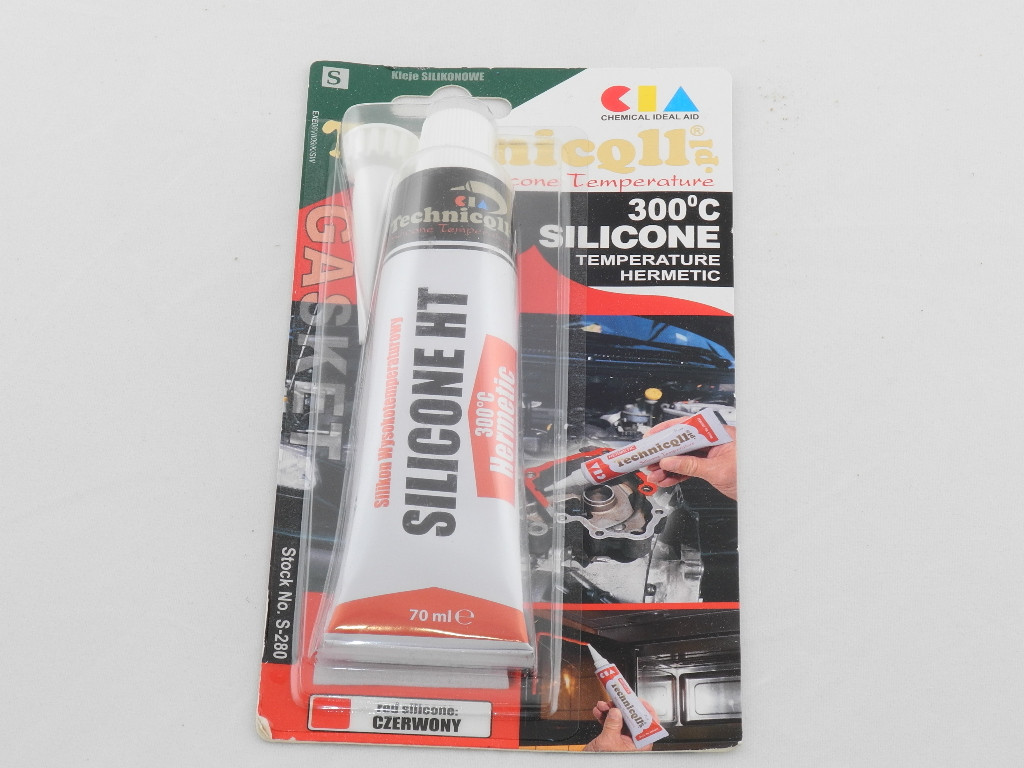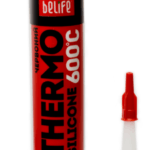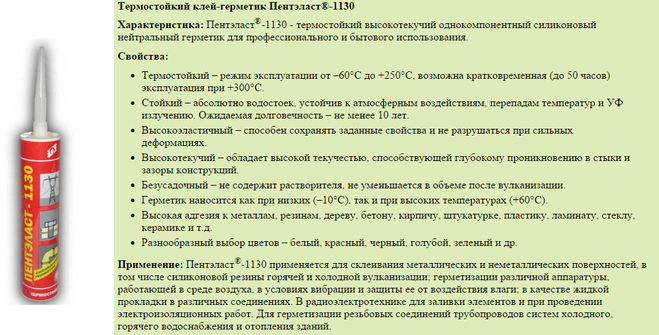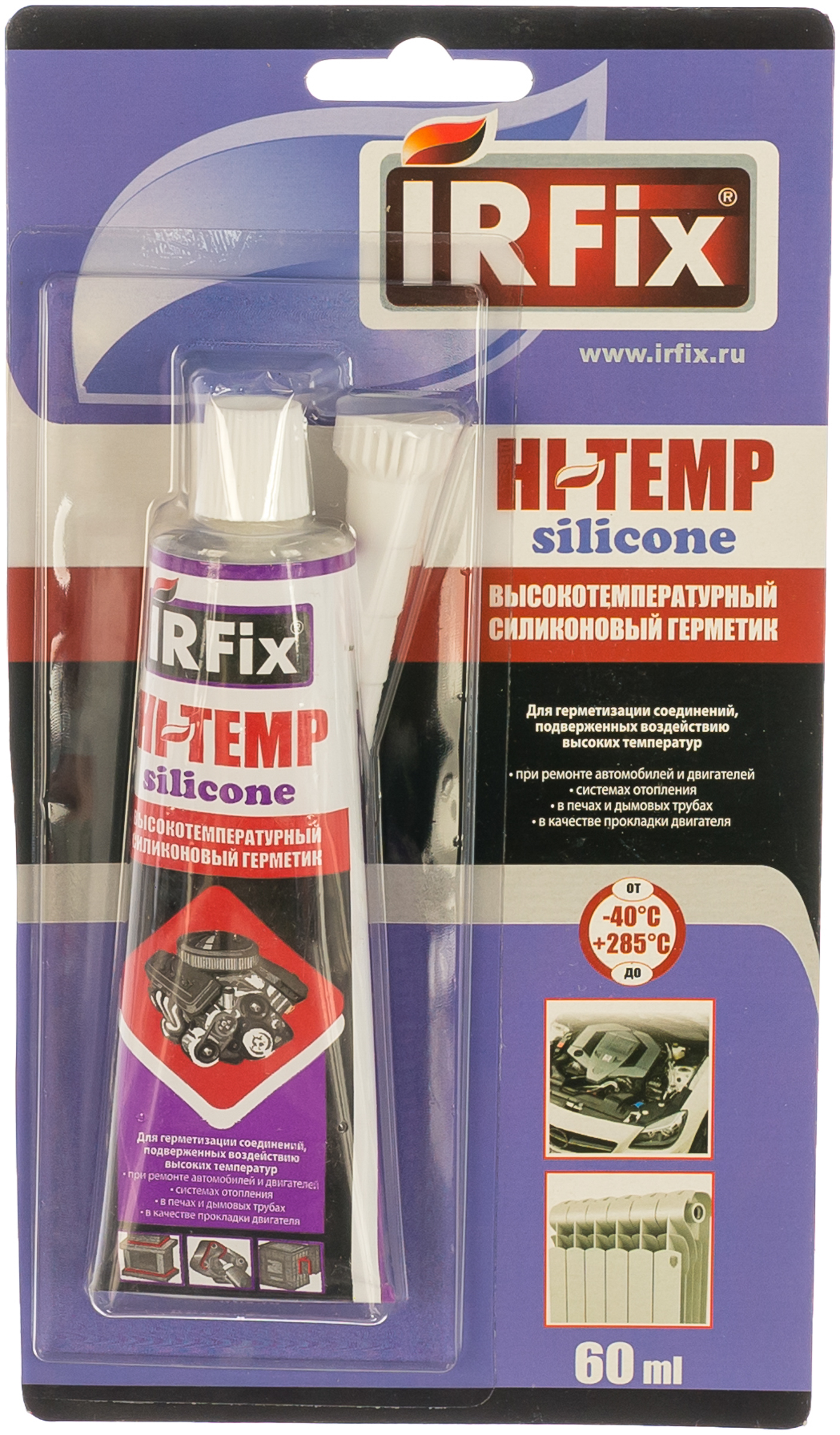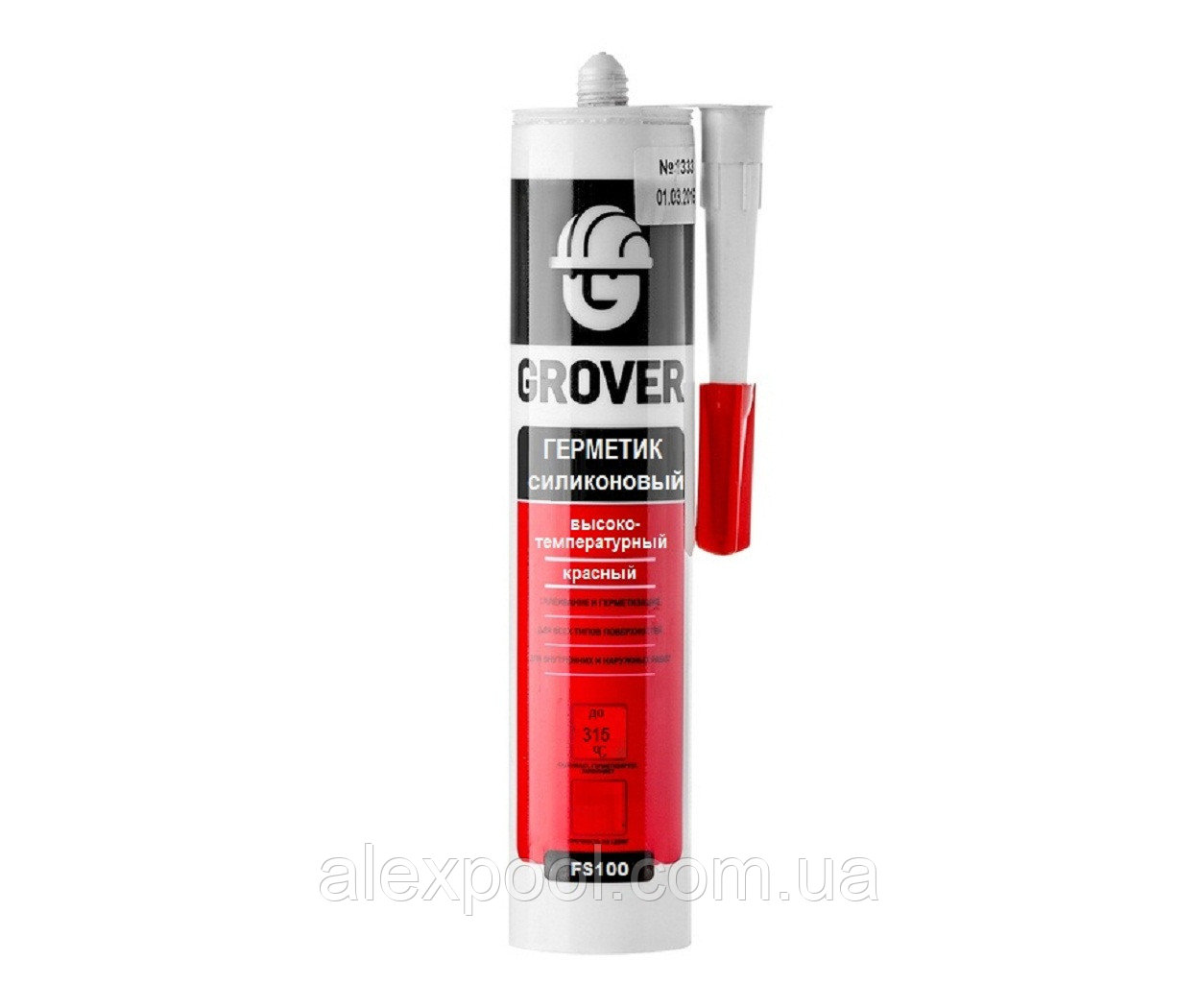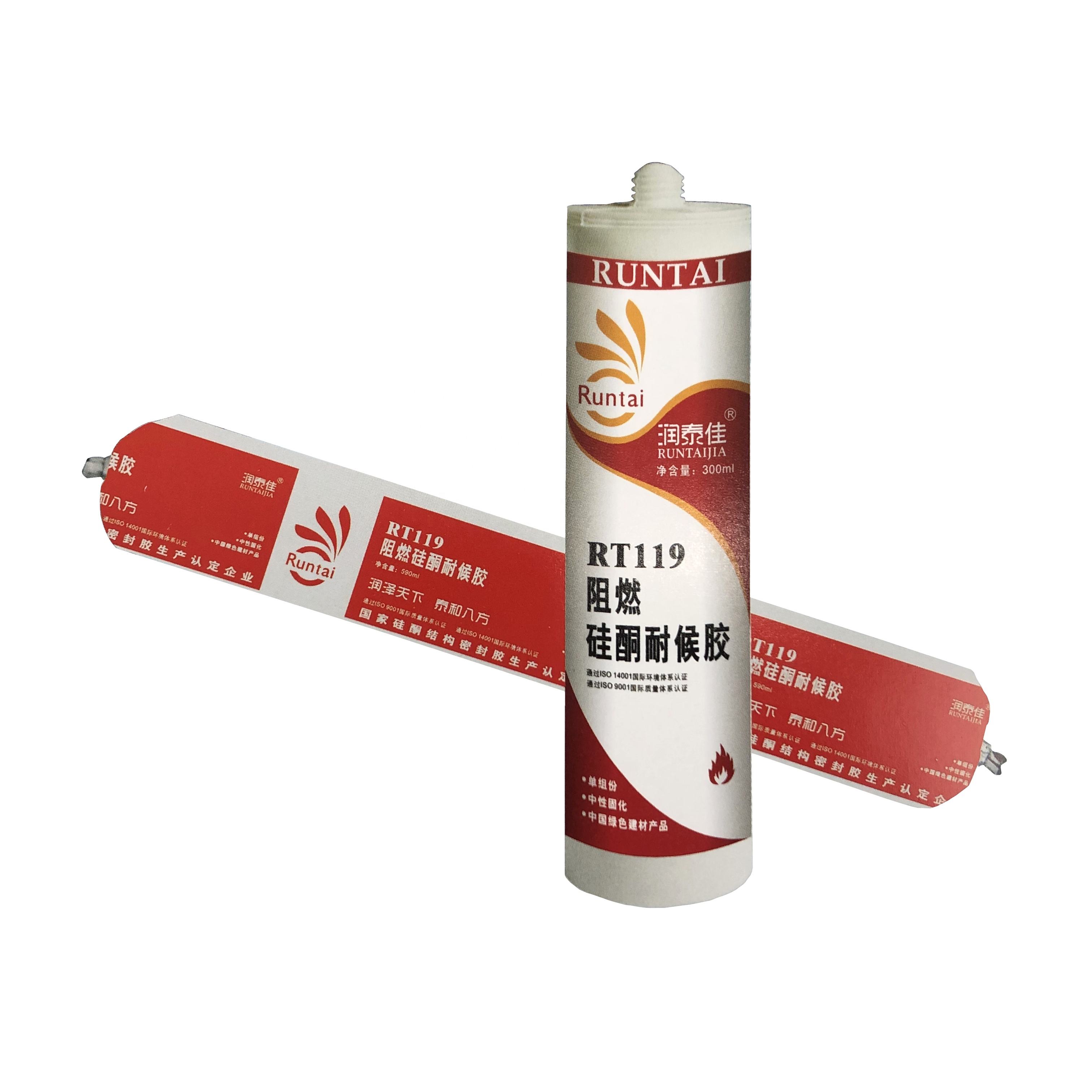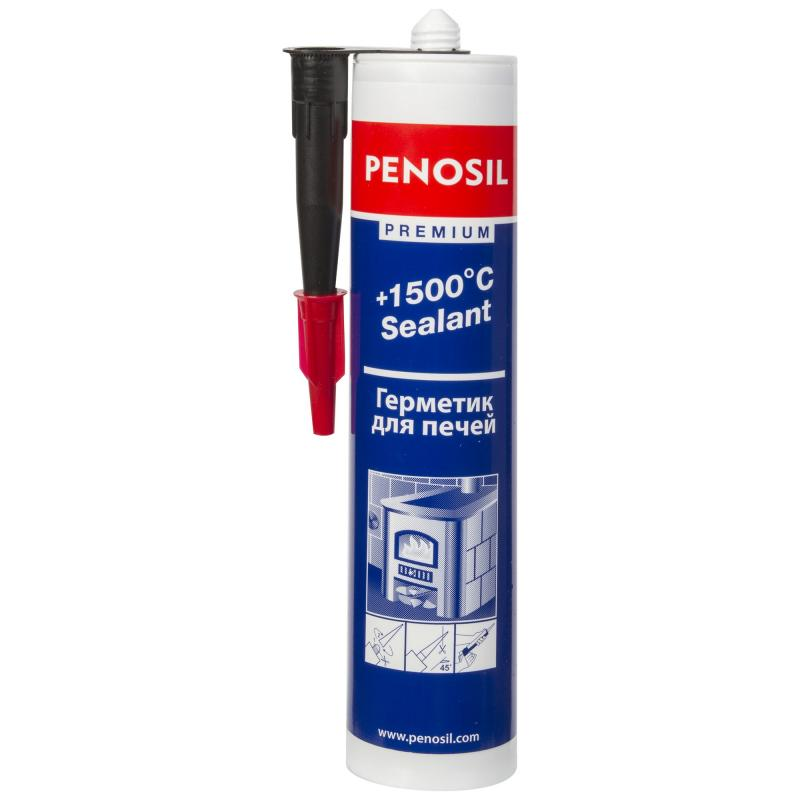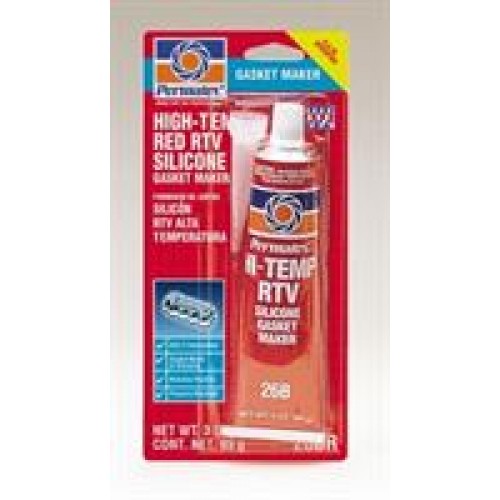Types of thermosealants by release form
Most manufacturers sell oven insulating compounds in tubes. Before use, the cylindrical container is installed in a construction gun.
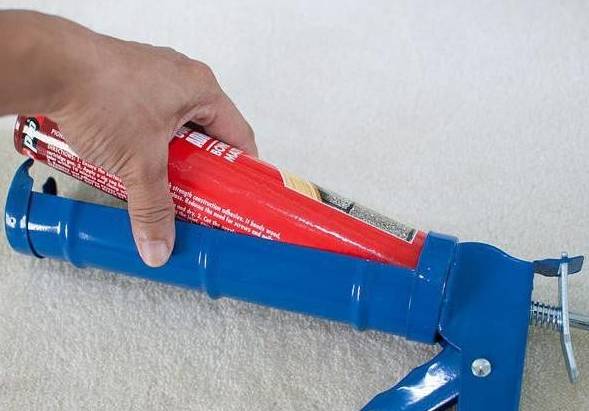

There are products in soft small tubes. It is advisable to use them for processing small areas. No additional tools are needed to apply the composition.
High-temperature sealants are available in the form of one- or two-component formulations. The first category is most actively used in everyday life.
The one-component composition is ready to use, does not require any preparation. Such a sealant dries longer, leaving time in stock to correct possible errors.
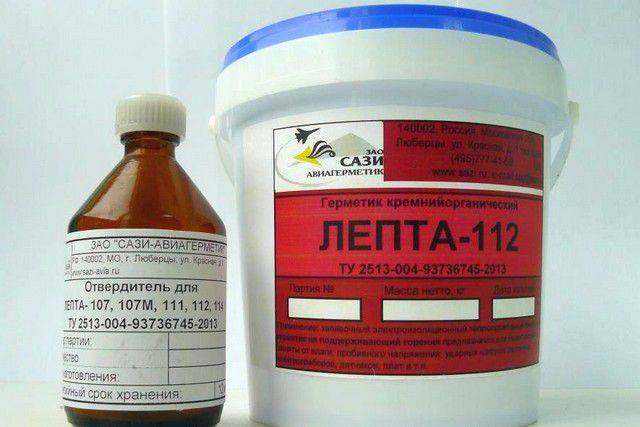

How to Apply Heat Resistant Sealant Carefully
To make it convenient to repair a stove or chimney with a sealant, you need to prepare some tools and materials.
So, you will need:
- Construction nailer or syringe.
- Rubber spatula.
- Stationery knife.
- Gas burner and, accordingly, a filled canister for it.
- Sealing compound in a cartridge.
- Masking tape.
- Rubber gloves.
In the case when a paste is purchased in a tube, a construction syringe is not required, and when using a heat-resistant sealant, there is no need to prepare a burner and a gas cylinder for operation.
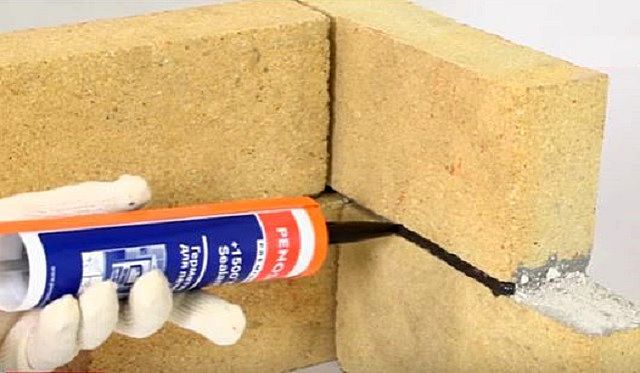
Sealing joints between bricks requires special care
When applying a sealant on a surface, special care is required to fill seams or cracks, especially if it is necessary to preserve the neat appearance of the masonry made "for joining"
For high-quality performance of such work, it is advisable to take into account a couple of tips from experienced craftsmen:
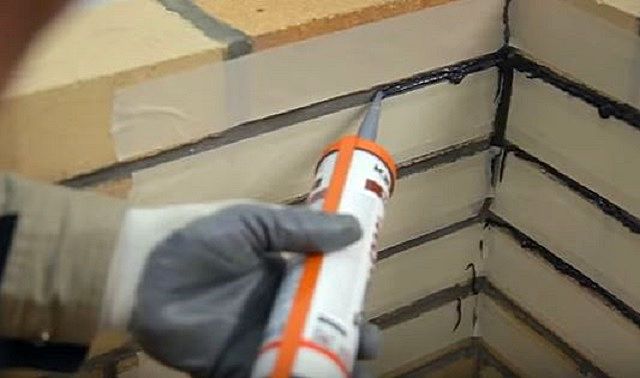
In order not to stain the surface of the brickwork with sealant, a reasonable solution would be to seal it with masking tape, leaving only gaps along the line of the seams to be closed
To prevent the sealant from getting on the surface of the brick and, but filling only the crack or seam, the surfaces can be sealed with masking tape of the required width. The tape is glued along the seam line, then the gap is filled with sealing paste, about one centimeter deep. If necessary, the sealant is leveled with a rubber spatula and there is no need to be afraid that the dark composition will stain the surface of the wall. After the paste has set, the tape is removed. This method will allow you to keep the seams in their original width and not spoil the neat appearance of the brickwork with a dark paste.

The nose of the tube is cut so that the hole turns out to be slightly beveled, and its diameter is slightly less than the width of the seams to be closed.
You can solve this problem in another way, without using scotch tape. To do this, when preparing a tube for work, you should not immediately cut off its nose to the maximum. In addition, the cut must be made at a slight angle and so that the hole is 2 ÷ 3 mm smaller than the seam width - this will help control the amount of sealant squeezed out. True, with this approach, there remains the risk of accidental ingestion of the composition on the surface of the brick, so the use of scotch tape is definitely the best solution.
Taking these recommendations into account, you can proceed directly to the process of applying the sealing compound. The works are carried out in the following order: In the first step, using a sharp knife, a sealed cap is cut from the cartridge, which closes the tube.
In the first step, using a sharp knife, a sealed cap is cut from the cartridge, which closes the tube.
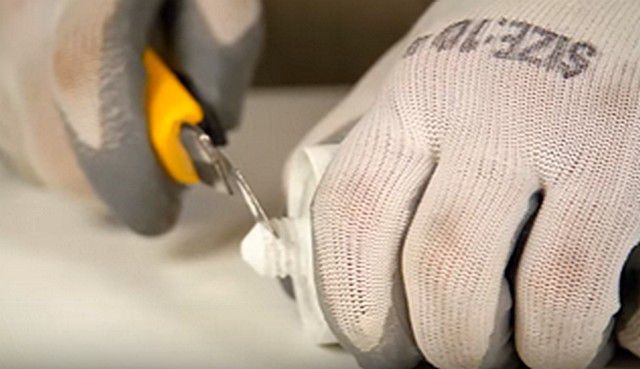
This cap is cut completely, to its full width.
- Further, a spout is screwed onto it, which is already cut off as recommended above.
- In the next step, the tube is installed in the assembly gun, which is being prepared for work in accordance with the peculiarity of its design.

When working with an assembly gun, you must rely on the instructions for its use - there may be differences
Further, before applying the sealant to the seam, crack or gap between the brick and the cast-iron part, the surface must be carefully prepared:
- Remove dust and dirt.
- Surfaces that are too smooth must be sanded to increase adhesion and then cleaned again.
- After that, the surfaces are degreased and completely dried. To speed up this stage of work, you can use a blow dryer to dry.
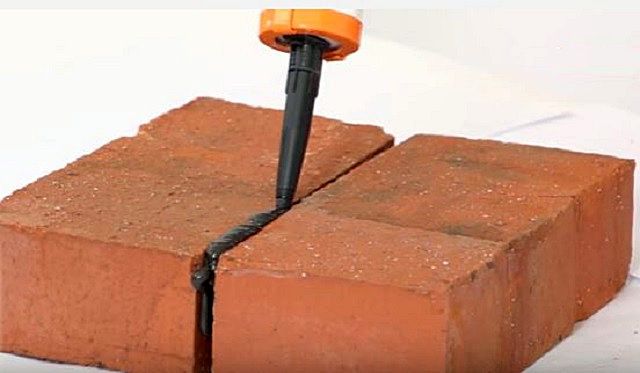
Filling the joint between bricks with heat-resistant sealant
- When the surface is dry, you can start filling the gap with a sealant mixture.
- Further, if a heat-resistant paste was used for sealing, then it is left to dry for a while. The packaging usually indicates the exact length of time the sealant will dry before the next phase of work can begin. Usually this period is about a day.
After the specified instructions for curing the composition, it is recommended to burn it with a gas burner flame
The final step is firing the hardened sealant layer with a portable gas burner. After such processing, the material during operation will be able to withstand temperatures up to 1500 degrees.
Of course, only one of the commercially available sealants has been shown as an example. For other formulations, some differences in application technology are possible. In any case, you must carefully study the instructions supplied by the manufacturer.
Peculiarities
The main active ingredient in the sealant is a polymer material. Depending on the purpose of application, it can be silicone, silicate, rubber, bitumen. The sealant is produced in tubes intended for manual use or using a special feeding device - a mounting gun.
V depending on its composition heat-resistant sealant is produced in three types - one-, two- or three-component.
One-component sealant is a product that can be used ready-made, and the composition polymerization process takes place at room temperature for several hours. At the same time, it is not required to apply a sealant with a thick layer - a layer with a thickness of 2 to 10 millimeters will quite cope with the task assigned to it. Each manufacturer indicates more specific parameters on the packaging of their products and they may differ for different brands.
- A two-component sealant consists of a base and a catalyst. The polymerization process takes place when these two components interact. The resulting mixture must be used immediately, since it cannot be stored.
- The three-component sealant consists of a main component, a curing compound and a catalyst that accelerates the curing process.
High temperature sealants fall into two categories.
- Heat-resistant sealants can withstand temperature loads within 1300 degrees. The components of such a sealant are capable of contacting with an open flame. The product contains sodium silicate. In turn, heat-resistant sealants are either fire-resistant or fire-resistant. The difference between them lies in temperature conditions and a number of characteristics.
- Heat-resistant sealants can be used in those areas of the structure that do not exceed a temperature of more than 350 degrees in heating. As a rule, these are elements of joints, joints and slots on the outer surfaces of the structure.
According to the composition of the polymeric substance, sealing products are of several types.
- Acidic - sealants that form acetaldehyde during polymerization. This substance can destroy or deform the surface that will react with it. Therefore, acidic sealants can only be used to a limited extent. So, for example, metal surfaces will quickly corrode, while concrete or cement will give powdery oxidation.
- Neutral - a type of sealant that consists of heat-resistant silicone and releases water and ethanol during polymerization. Their use is safe for all types of surfaces, and therefore these sealants have a fairly wide range of uses. The silicone seam is perfectly restored after any deforming effects, and its service life is at least 15 years.
In addition to their distinctive features, all types of heat-resistant sealants share common properties.
- Adhesiveness - the polymer components that make up all heat-resistant sealing products have good adhesion to working surfaces. They can be used on brick, concrete, metal, glass, ceramic, wood or plastic construction.
- Plasticity - the sealing joints after the end of the polymerization time have a certain plasticity. They do not crack, are resistant to vibration and temperature extremes.
- Water resistance - polymer materials are highly resistant to water and steam.
- UV Resistant - Polymer sealants are not susceptible to the damaging properties of UV rays.
According to the scope of application, heat-resistant sealants can be divided into three types.
- for use in construction and installation works;
- used for the repair of motor vehicles;
- narrow-profile special-purpose sealants.
Types of sealants and materials
The main component of sealants is polymers. In this case, different polymers are used and give different characteristics to the basic composition. They are packaged in tubes of different sizes and configurations. Some resemble tubes of toothpaste and are squeezed out as well. There is Tubes for a mounting gun... In this case, the spout is cut off on the cone of the lid, the tube is installed in the device, squeezing out the required amount using the trigger lever.

Heat resistant sealant in a tube
There are two-component formulations that need to be mixed before work. They are more often used by professionals due to strict requirements: when mixing, it is required to measure parts with high accuracy (the permissible error is only 0.5-1 grams). In addition, if even a small part of one component accidentally gets into another, a reaction occurs, and the shelf life of the mixture is only a few hours. In general, ready-made paste sealants are easier to use.
For chimneys and stoves, special high-temperature compounds are used. High temperature sealants come in two categories:
- Heat resistant. Used for places that heat up to 350 ° C. The area of their use is the outer surfaces of stoves and fireplaces - gaps between masonry bricks (but not between furnace casting and masonry), sealing the joints of brick chimneys, sandwiches and roofs (but not simple metal chimneys), parts of the heating system and hot water supply, etc. etc.
- Heat resistant or heat resistant. They withstand very high temperatures - up to 1500oC. Scope: if we talk about stoves and fireplaces - joints of casting and masonry, in boilers - in combustion chambers or furnaces, in chimneys - joints and seams, including immediately after the outlet of the chimney. These compositions can be used in places of direct contact with a flame, but then there must be one more characteristic: fire-resistant or refractory.
One of these sealants is used depending on the temperature and performance required.So the oven sealant, depending on the area of application, can be either heat-resistant silicone or heat-resistant silicate. To understand what is the difference between them, what they are, how to use them, consider the properties and characteristics.
Recommendations: how to choose a sealant
Having familiarized yourself with the unique properties of the building material and having decided on the appropriate type of sealant, you can go shopping. Here the following problem arises: among the variety of goods on the modern market, it is necessary to choose a really high-quality product. When choosing a brand of a well-known manufacturer, keep in mind that its composition must be elastic, adhesive and resistant to temperature extremes, chemical and natural influences. A good sealant compensates for any movement of the joints, does not form voids or cracks.
Decide on the type of work: indoors you need material for indoor installation, outdoors - for outdoor. The manufacturer indicates this information on the label. The condition and type of surface for which a component is selected also affects the choice of sealant. For such cases (wet or worn surface, rust), the substance contains additional properties.
Specify the information for which type of work a particular product is suitable: roofing or window work, for stoves and fireplaces, or a universal sealant. Consider the mobility of the material under the influence of heat or after solidification - will it expand or not. Consider in advance about the possibility of further painting, since, for example, a silicone one-component sealant is not subject to this.
The rating of high-quality sealing compounds in 2020 will help to avoid a deadlock when choosing the right brand. The construction tool review was compiled on the basis of positive feedback from buyers who have already tested the material in the case.
A description of the advantages and disadvantages of the product, its scope will tell you what to look for before purchasing
How to choose the right one?
If you notice that smoke or combustion products get into the room or surrounding space, then you should conduct a complete revision of the system and find the hole. A number of parameters need to be assessed, including:
- Dimensions;
- Location;
- Surrounding material.
After that, you determine the approximate temperature that is reached during active use. If the surface is in the immediate vicinity of the flames, then the choice is obvious - choose a heat-resistant sealant with a maximum temperature.
It can be difficult to determine the approximate temperature. If you are not sure which brand to choose, then choose the heat-resistant option. Its cost will be orders of magnitude higher than analogs, however, in this way you can protect yourself from the occurrence of a repeated malfunction.
If the identified hole is in contact only with smoke or combustion products, then a heat-resistant sealant should be used. It is also often used at the junctions of individual chimney components. It is much safer and more profitable to use monolithic structures even during construction in order to minimize the likelihood of such a breakdown.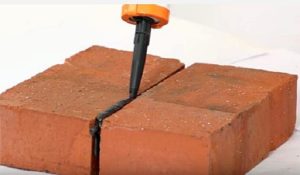
The hole may be oversized. In such cases, using artificial sealants does not make much sense, since there is a great chance that it will simply burn out. In this case, a silicate sealant for ovens is purchased, which reliably hides the detected defect. For the best result, it is necessary to provide sufficient access, therefore, a partial disassembly of the furnace with subsequent repairs is required.
Varieties and classification of sealants
All types of modern sealants are distinguished by the fact that after applying them to a particular surface, they dry out quickly enough and ideally retain all their characteristics.Such compositions work over a fairly wide temperature range, ranging from 300 to 1500 degrees.
It is for this reason that such mixtures are used to seal cracks and seams, which is important in the process of installing a chimney and heating system, various boilers
All sealants are pasty in structure, which hardens quickly after application. There are quite a few sealed compounds, but only heat-resistant compounds are used to equip fireplaces with different designs of stoves and chimney systems. The level of temperature withstand is usually directly dependent on the polymer present in the composition. In direct dependence on the features, materials are silicate, silicone, and bituminous.
In turn, the polymer base affects the scope of application of the sealant. Already on the basis of this, a special classification of hermetic pastes is distinguished. Based on this, the following sealants are distinguished:
- Construction.
- Automotive.
- Narrowly targeted or special.
This is the purpose of the material, which is indicated on the packaging. There is no clearly defined boundary between different areas of application, but it is better to use modern sealants solely for their intended purpose. Compositions of such a plan are sold in different volumes, but to solve problems related to tightness, it is better to purchase sealants in tubes that are equipped with special tips.
This category of sealants belongs to the category of high-temperature compounds. They are able to withstand quite serious heating without loss of quality. The degree of heat resistance of sealants can be different and in this category there are two main groups of materials:
- Heat resistant.
- High temperature.
These sealants differ in a certain ability to withstand high temperatures. Simple heat-resistant sealants are able to withstand temperatures not exceeding 300 degrees, as for heat-resistant ones, they can effectively withstand temperatures up to 1500 degrees.
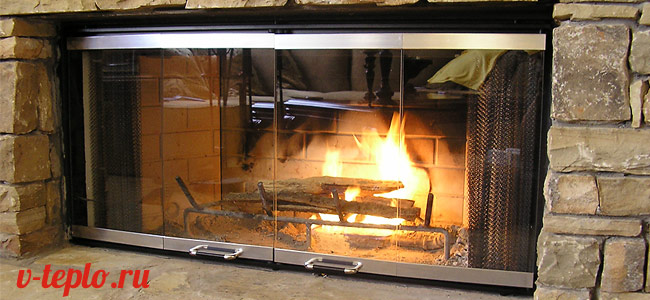
Among these two categories, it is heat-resistant sealants that are very popular. They are available in black and gray. These formulations are simply irreplaceable. to effectively eliminate leaks in heating boilers. Also, sealants of this category can reliably and firmly bond with the most popular building materials - metal, cement, concrete, brick, stone. The advantage of modern heat-resistant compounds is that they adhere very well to fairly smooth surfaces. It is for this reason that no abrasive blasting is required to work with these sealants.
The main properties of heat-resistant sealants
High-temperature sealants can be used not only in the arrangement of a country house, but also in the modern professional construction industry. Household and professional sealants differ slightly in characteristics, that is, the latter are able to withstand a higher temperature regime. The main properties of sealants include the following factors:
- Sealants can effectively protect devices, as well as modern equipment from the influence of high humidity and various chemical elements.
- Manufacturers produce a fairly wide range of colors of heat-resistant sealants. You can choose a shade that is ideal for arranging absolutely any surface.
- The composition of the sealants provides an ideal strong adhesion to such structural substrates as metal, stone, cement concrete, tiles and bricks.
- Sealants are used not only in the arrangement of stoves, modern fireplaces, but also in the process of arranging a modern insulated floor, ventilation ducts, fire door structures, and so on.
- The use of sealant makes it possible to seriously reduce the protection of the structure from possible fire.
The need to use heat-resistant sealants is based primarily on the desire to tightly seal cracks or cracks that often appear next to pipes and chimneys.
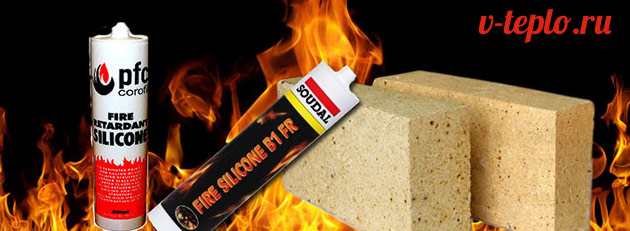
Owners of brick houses and fireplaces very often face similar problems. These are materials, devices, which are quite specific. Bricks tend to crack strongly due to constant temperature differences. Slots are formed, which often become through and go out into the smoke channel and into the firebox. This causes not only the formation of soot on the walls, but also the release of combustion products harmful to humans, which in large quantities can cause serious poisoning. There is another problem associated with the high probability of fire.
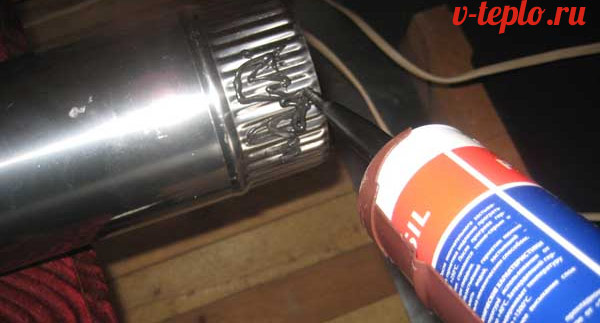
This is based on the fact that a large amount of soot accumulates on the chimney due to leakage. If not removed if exposed to air, it may catch on fire. The temperature when the furnace is operating can reach 1500 degrees, and if the insulation is insufficient, there is a risk that the roof will catch fire after a certain time.
You cannot do without a sealant when working with a modern gas boiler. If the chimney is leaky, the burner flame will constantly extinguish. During the operation of gas-fired heating equipment, this is a fairly common phenomenon. In order not to check the operation of the boiler several times a day, so as not to fire it up constantly, it is worth sealing all the cracks with a high-quality sealant.
Properties and specifications of food grade sealant
In appearance, food grade silicone sealant resembles a colorless transparent or white matte paste, which is easily squeezed out of a tube and hardens after contact with moisture from the air at different time intervals (depending on the brand, composition). The main difference between the material and other silicone sealants is its safety for health, the absence of harmful impurities and the release of toxic substances from high temperatures. It is these properties that make the product suitable for dishes, food equipment, ovens, and household appliances.
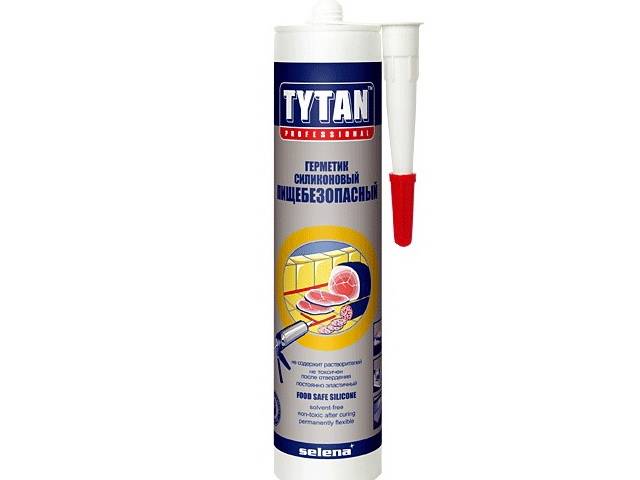
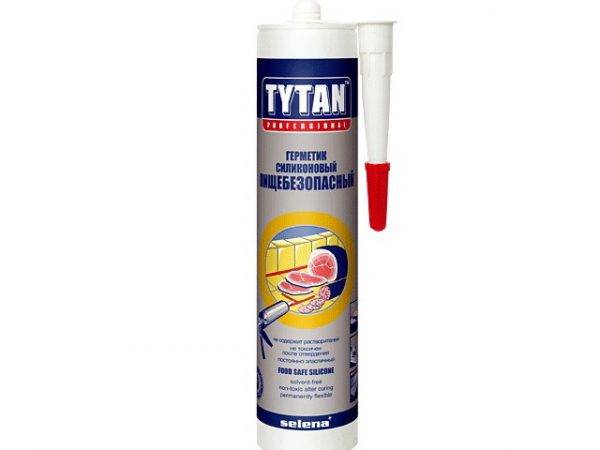
Most often, these sealants are used for the following purposes:
- filling seams in containers with water, filtering devices, reservoirs;
- strengthening of joints, gaps at objects in the food industry, dairy farms, slaughterhouses, catering establishments;
- sealing of pipe joints for the supply of warm, cold water in the city, countryside;
- sealing various surfaces in institutions where sterility is required (operating rooms, other hospital rooms);
- repair of home and professional household appliances: gas and electric stoves, electric kettles, multicooker, moonshine, etc.
The sealant can be applied without dripping, displacement on any substrate: horizontal, vertical. After polymerization, the seam turns into a durable silicone rubber, which is food safe and can come into contact with water, food. On the packaging, the sealant must be marked "with approval for use in the food industry", which confirms its non-toxicity.
Most food grade sealants are high temperature (heat resistant), which means they can be used to repair hot items without losing their properties or breaking the seam. Sealants are distinguished by their waterproofness, excellent adhesion to glass, ceramics, metal, hard plastic, enamelled and painted materials. The joint created by the sealant does not react to the influence of alcohols, cleaning agents, fats and oils. It is elastic and will not freeze crack.
The technical characteristics of quality silicone sealants are as follows:
- high mechanical resistance, the ability to stretch during the formation of cracks on the main product;
- significant chemical resistance, ability to withstand the influence of weak acids and alkalis;
- wear resistance, non-exposure to atmospheric factors;
- the ability to quickly form a protective film (after about 10 minutes) and quick final drying (from 2 hours to a day);
- tolerance to temperature changes from -40 to + 180-350 degrees and more.
The most popular brands of food grade sealants are Tytan Food Safe Silicone Sealant, Gebsicone Mastic silicone, Master Sil, and others.
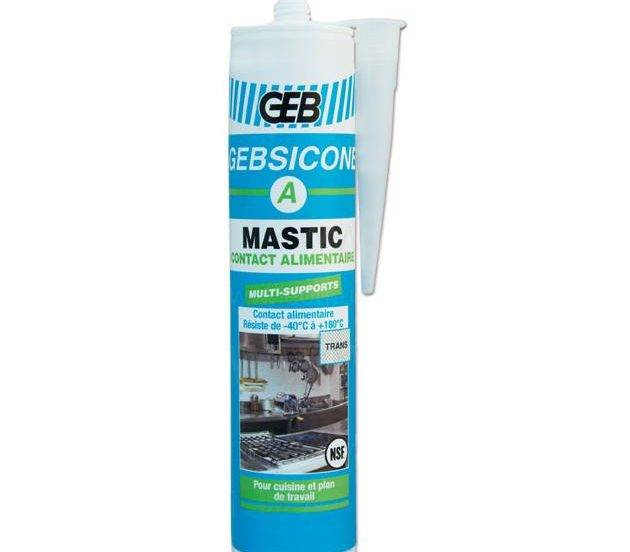

Specifications
Fireplace sealant and glue are different substances with several basic parameters. To understand their differences, you need to consider the properties of these products.

Sealants are special formulations based on various chemicals. The main purpose of such mixtures is to fill seams, cracks and other formations in the frames of furnaces, fireplaces, etc. They are able to withstand significant temperatures. According to this characteristic, the main types of sealants can be distinguished:
- heat-resistant pastes capable of withstanding high-temperature conditions up to values not exceeding 350 degrees Celsius. They are used on the outer surfaces of stoves or fireplaces. Often, this type of sealant is used to seal cracks, joints and other holes in places with high temperatures.
- heat-resistant and heat-resistant compounds are used in places that heat up to 1500 degrees Celsius. The main purpose is to repair damage to brickwork and other similar places where such a high temperature is present. Some types of such sealants can easily withstand exposure to open fire.

When choosing a sealant for fireplaces and stoves, you should pay attention to its type and operating conditions. This will provide an opportunity to purchase a high-quality and reliable product that can solve a specific problem.
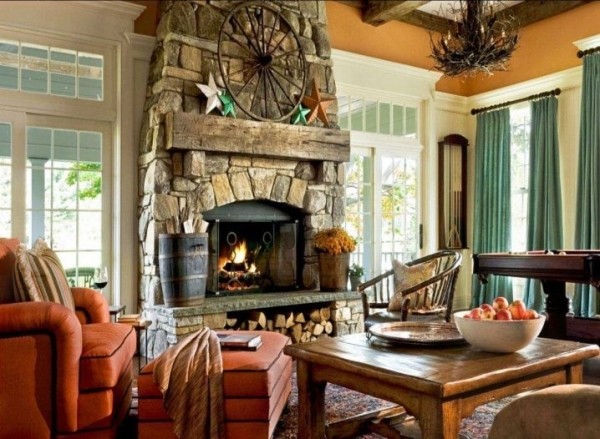
Fireplace glue is a special solution that is often used for masonry. There are several types of similar compositions on the market:
- Heat-resistant solutions are able to withstand (about 3 hours) temperatures of at least 140 degrees.
- Thermal glue perfectly withstands the same temperature range as in the first paragraph, but here their properties are no longer violated after a certain time.
- Heat-resistant mixtures have the ability to withstand temperatures in the region of 200 degrees without losing their basic properties.
- Heat-resistant, heat-resistant glue has the characteristics of the previously considered substances, but they can be used already when heated to 1000 degrees.
- Fire-resistant solutions retain their technical characteristics when exposed to open fire for at least 3 hours. It should be noted that such an adhesive has high chemical resistance, which prevents any reactions with active unburned particles from occurring.
- Refractory glue has the same parameters as fire-resistant substances, but at the same time it can withstand the effects of fire indefinitely.

It should be noted that according to its intended purpose, glue for fireplaces can also be conditionally divided into masonry and tile (finishing). Each of these types of solutions has a different adhesive tack and viscosity. Ready-made fireplace solutions consist of several main components:
- Clay-cement binders, fireclay fiber and many others. Their combination depends not only on the heat resistance, but also on the adhesion of the solution.
- Binders. These include aluminosilicate cements and kaolin. Also, in some cases, water glass and other components are added.
- Mineral plasticizer based on talcum powder.
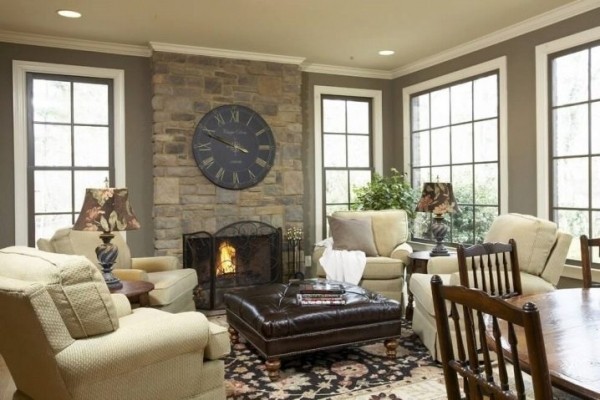
It should be noted that glue for a fireplace can have a different composition, which is combined to impart specific properties to it.
